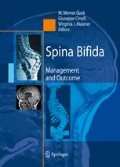Abstract
In 1957, Cameron [1] first noted the association of spina bifida with several supratentorial abnormalities such as polymicrogyria, cortical heterotopia, corpus callosum dysgenesis, thickening of the massa intermedia, hypoplasia of the falx and aqueductal stenosis and forking. All of Cameron’s patients also suffered from the Chiari II malformation [2].
Access this chapter
Tax calculation will be finalised at checkout
Purchases are for personal use only
Preview
Unable to display preview. Download preview PDF.
References
Cameron AH (1957) The Arnold-Chiari and other neuroanatomical malformations associated with spina bifida. J Pathol Bacteriol 73:195–211
Cameron AH (1957) Malformations of the neurospinal axis, urogenital tract and foregut in spina bifida attributable to disturbances of the blastopore. J Pathol Bacteriol 73:213–221
Gilbert JN, Jones KL, Rorke LB et al (1986) Central nervous system anomalies associated with menin go — myelocele, hydrocephalus, and the Arnold-Chiari malformation: Reappraisal of theories regarding the pathogenesis of posterior neural tube closure defects. Neurosurgery 18(5):559–564
Kawamura T, Morioka T, Nishio S et al (2001) Cerebral abnormalities in lumbosacral neural tube closure defect: MR imaging evaluation. Childs Nerv Syst 17:405–410
Yoshida F, Morioka T, Hashiguchi K et al (2006) Epilepsy in patients with spina bifida in the lumbosacral region. Neurosurg Rev 29:327–332
Fletcher JM, Copeland K, Frederick JA et al (2005) Spinal lesion level in spina bifida: a source of neural and cognitive heterogeneity. J Neurosurg (Pediatrics 3) 102:268–279
McLone DG, Knepper PA (1989) The cause of Chiari II malformation: a unified theory. Pediatr Neurosci 15:1–12
McLone DG, Dias MS (2003) The Chiari II malformation: cause and impact. Childs Nerv Syst 19:540–550
Coulombre AG, Coulombre JL (1958) The role of mechanical factors in brain morphogenesis (abstract). Anat Rec 130:289–290
Desmond ME, Jacobson AG (1977) Embryonic brain enlargement requires cerebrospinal fluid pressure. Dev Biol 57:188–198
Mashayekhi F, Draper CE, Bannister CM et al (2002) Deficient cortical development in the hydrocephalic Texas (H-Tx) rat: a role for CSF. Brain 125:1859–1874
Gross H, Jellinger K, Kaltenbac E (1974) Progressive hydrocephalus associated with spina bifida caused by a peculiar cerebellum-brain stem syndrome. Presented at the VIIth International Congress of Neuro path — ology, Budapest, Hungary
Barkovich AJ, Chuang SH, Norman D (1988) MR of neuronal migration anomalies. AJR 150:179–187
Barkovich AJ, Kjos BO (1992) Gray matter heterotopias: MR characteristics and correlation with developmental and neurologic manifestations. Radiology 182:493–499
Barkovich AJ (1996) Subcortical heterotopias: a distinct clinicoradiologic entity. AJNR Am J Neuroradiol 17:1315–1322
Barkovich AJ, Jackson DE, Boyer R (1989) Band heterotopias: a newly recognized neuronal migration anomaly. Radiology 171:455–458
Cho WH, Seidenwurm D, Barkovich AJ (1999) Adultonset neurologic dysfunction associated with cortical malformations. AJNR Am J Neuroradiol 20:1037–1043
Sisodiya S M (2004) Malformations of cortical development: burdens and insights from important causes of human epilepsy. Lancet Neurol 3:29–38
Thompson JE, Castillo M, Thomas D et al (1997) Radiologic-pathologic correlation polymicrogyria. AJNR Am J Neuroradiol 18:307–312
Barkovich AJ, Gressens P, Evard P et al (1992) Formation, maturation, and disorders of brain neocortex. AJNR Am J Neuroradiol 13:423–446
Norman MG, McGillivray BC, Kalousek DK et al (1995) Neuronal migration diseases and cortical dysplasia. In: Norman MG, McGillivray BC, Kalousek DK et al (eds) Congenital malformations of the brain. Oxford University Press, New York, pp 223–279
Muller J (1983) Congenital malformations of the brain. In: Rosenberg RN (ed) The clinical neurosciences, vol 3. Churchill, New York, pp 1–33
MacFarlane A, Maloney AFJ (1957) The appearance of the aqueduct and its relationship to hydrocephalus in the Arnold-Chiari malformation. Brain 80:479–493
Peach B (1965) Arnold-Chiari malformation. Anatomic features of 20 cases. Arch Neurol 12:613–621
Takanashi J, Barkovich J (2003) The changing MR imaging appearance of polymicrogyria: a consequence of myelination. AJNR Am J Neuroradiol 24:788–793
Barkovich AJ, Hevner R, Guerrini R (1999) Syndrome of bilateral polymicrogyria. AJNR Am J Neuroradiol 20:1814–1821
Bourgeois M, Sainte-Rose C, Cinalli G et al (1999) Epilepsy in children with shunted hydrocephalus. J Neurosurg 90:274–281
Chadduck W, Adametz J (1988) Incidence of seizures in patients with myelomeningocele: A multifactorial analysis. Surg Neurol 30:281–285
Talwar D, Baldwin MA, Horbatt CI (1995) Epilepsy in children with meningomyelocele. Pediatr Neurol 13:29–32
Kawamura T, Nishio S, Morioka T, Fukui K (2002) Callosal anomalies in patients with spinal dysraphism: correlation of clinical and neuroimaging features with hemispheric abnormalities. Neurol Res 24:463–467
Dobyns WB (1996) Absence makes the search grow longer. Am J Hum genet 58:7–16
Sztriha L (2005) Spectrum of corpus callosum agenesis. Pediatr Neurol 32:94–101
Huber-Okrainec J, Blaser SE, Dennis M (2005) Idiom comprehension deficits in relation to corpus callosum agenesis and hypoplasia in children with spina bifida meningomyelocele. Brain Lang 93:349–368
Razavi FE (2003) Identification of brain malformations: neuropathological approach. Childs Nerv Syst 19:448–454
Osaka K, Tanimura T, Hirayama A, Matsumoto S (1978) Myelomeningocele before birth. J Neurosurg 49:711–724
Rollins N, Joglar J, Perlman J (1999) Coexistent holoprosencephaly and Chiari II malformation. AJNR Am J Neuroradiol 20:1678–1681
Barkovich AJ, Quint DJ (1993) Middle interhemispheric fusion: an unusual variant of holoprosencephaly. AJNR Am J Neuroradiol 14:431–440
Author information
Authors and Affiliations
Rights and permissions
Copyright information
© 2008 Springer-Verlag Italia
About this chapter
Cite this chapter
Spennato, P., Savarese, L., Buonocore, M.C., Cianciulli, E., Cinalli, G. (2008). Supratentorial Cerebral Malformations in Spina Bifida. In: The Spina Bifida. Springer, Milano. https://doi.org/10.1007/978-88-470-0651-5_21
Download citation
DOI: https://doi.org/10.1007/978-88-470-0651-5_21
Publisher Name: Springer, Milano
Print ISBN: 978-88-470-0650-8
Online ISBN: 978-88-470-0651-5
eBook Packages: MedicineMedicine (R0)

